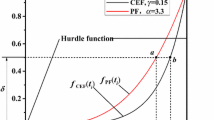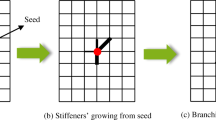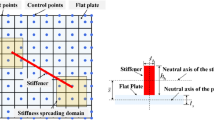Abstract
This paper studies maximum out-of-plane buckling load design of thin bending plates for a given amount of material. Two kinds of plates are considered. One is made of periodic homogeneous porous material. Another is uniformly stiffened solid plate. The plate material, thickness, design domain of its middle plane and boundary conditions are given. The pattern of prescribed in-plane external load or displacements along the part of boundaries, which move freely, is given. Both plate topology and micro-structural topology of porous material or stiffener layout are concurrently optimized. The artificial element material densities in both macro and micro-scale are chosen as design variables. The volume preserving nonlinear density filter is applied to obtain the black-white optimum topology and comparison of its different sensitivities is made to show the reason for oscillation during optimization process in Appendix. The new numerical implementation of asymptotic homogenization method (NIAH, Cheng (Acta Mech Sinica 29(4): 550–556, 2013) and Cai (Int J Solids Struct 51(1), 284–292, 2014) is applied to homogenization of periodic plate structures and analytic sensitivity analysis of effective stiffness with respect to the topological design variables in both macro-scale and micro-scale. On basis of that, this paper implements the sensitivity analysis of out-of-plane buckling load by using commercial FEA software and enables the application of gradient-based search algorithm in optimization. Several numerical implementation details are discussed. Three numerical examples are given to show the validity of this method.
















Similar content being viewed by others
References
Ambrosio L, Buttazzo G (1993) An optimal-design problem with perimeter penalization. Calc Var 1(1):55–69
Armand JL, Lodier B (1978) Optimal design of bending elements. Int J Numer Methods Eng 13(2):373–384
Bakhvalov N, Panasenko G (1989) Homogenisation: averaging process in periodic media. Kluwer Academic Publ, Dordrecht
Bendsøe MP (1989) Optimal shape design as a material distribution problem. Struct Optim 1:193–202
Bendsøe MP, Kikuchi N (1988) Generating optimal topologies in structural design using a homogenization method. Comput Methods Appl Mech Eng 71(2):197–224
Bendsøe MP, Sigmund O (2003) Topology optimization: theory, methods and applications, 2nd edn. Springer Berlin, Heidelberg, New York
Bensoussan A, Lions JL, Papanicolaou G (1978) Asymptotic analysis for periodic structures. North Holland Publ, Amsterdam
Bourdin B (2001) Filters in topology optimization. Int J Numer Methods Eng 50(9):2143–2158
Bruns TE, Tortorelli DA (2001) Topology optimization of non-linear elastic structures and compliant mechanisms. Comput Methods Appl Mech Eng 190(26–27):3443–3459
Cai Y, Xu L, Cheng GD (2014) Novel numerical implementation of asymptotic homogenization method for periodic plate structures. Int J Solids Struct 51(1):284–292
Cheng KT, Olhoff N (1981) An investigation concerning optimal design of solid elastic plates. Int J Solids Struct 17(3):305–323
Cheng GD, Cai YW, Xu L (2013) Novel implementation of homogenization method to predict effective properties of periodic materials. Acta Mech Sinica 29(4):550–556
Coelho PG, Fernandes PR, Guedes JM, Rodrigues HC (2008) A hierarchical model for concurrent material and topology optimization of three-dimensional structures. Struct Multidiscip Optim 35(2):107–115
Deng JD, Yan J, Cheng GD (2013) Multi-objective concurrent topology optimization of thermoelastic structures composed of homogeneous porous material. Struct Multidiscip Optim 47(4):583–597
Guedes JM, Lubrano E, Rodrigues HC, Turteltaub S (2006) Hierarchical optimization of material and structure for thermal transient problems. In: Iutam symposium on topological design optimization of structures, machines and materials: status and perspectives, vol 137, pp 527–536
Guest JK, Prévost JH (2006) Optimizing multifunctional materials: design of microstructures for maximized stiffness and fluid permeability. Int J Solids Struct 43(22):7028–7047
Guest JK, Prévost JH, Belytschko T (2004) Achieving minimum length scale in topology optimization using nodal design variables and projection functions. Int J Numer Methods Eng 61(2):238–254
Ji J, Ding XH (2014) Stiffener layout optimization of inlet structure for electrostatic precipitator by improved adaptive growth method. Adv Mech Eng 6:979604
Ji J, Ding XH, Xiong M (2014) Optimal stiffener layout of plate/shell structures by bionic growth method. Comput Struct 135:88–99
Kalamkarov AL (1987) On the determination of effective characteristics of cellular plates and shells of periodic structure. Mech Solids 22(2):175–179
Kalamkarov AL, Kolpakov AG (1997) Analysis, design, and optimization of composite structures. John Wiley & Sons, Chichester, New-York
Kolpakov AG (1991) Calculation of the characteristics of thin elastic rods with a periodic structure. J Appl Math Mech 55(3):358–365
Kolpakov AG (1998) Variational principles for stiffness of a non-homogeneous beam. J Mech Phys Solids 46(6):1039–53
Lindgaard E, Dahl J (2013) On compliance and buckling objective functions in topology optimization of snap-through problems. Struct Multidiscip Optim 47(3):409–421
Lindgaard E, Lund E (2011) A unified approach to nonlinear buckling optimization of composite structures. Comput Struct 89(3):357–370
Liu L, Yan J, Cheng GD (2008) Optimum structure with homogeneous optimum truss-like material. Comput Struct 86(13–14):1417–1425
Lund E, Stegmann J (2006) Eigenfrequency and buckling optimization of laminated composite shell structures using discrete material optimization. IUTAM Symposium on Topological Design Optimization of Structures, Machines and Materials. Springer Netherlands: 147–156
Luo J, Gea HC (1998) A systematic topology optimization approach for optimal stiffener design. Struct Optim 16(4):280–288
Neves MM, Rodrigues H, Guedes JM (1995) Generalized topology design of structures with a buckling load criterion. Struct Optim 10(2):71–78
Neves MM, Sigmund O, Bendsøe MP (2002) Topology optimization of periodic microstructures with a penalization of highly localized buckling modes. Int J Numer Methods Eng 54(6):809–834
Niu B, Yan J, Cheng GD (2009) Optimum structure with homogeneous optimum cellular material for maximum fundamental frequency. Struct Multidiscip Optim 39(2):115–132
Olhoff N (1970) Optimal design of vibrating circular plates. Int J Solids Struct 6(1):139–156
Olhoff N (1974) Optimal design of vibrating rectangular plates. Int J Solids Struct 10(1):93–109
Petersson J, Sigmund O (1998) Slope constrained topology optimization. Int J Numer Methods Eng 41(8):1417–1434
Prager W, Rozvany GIN (1977) Optimal layout of grillages. J Struct Mech 5(1):1–18
Rodrigues H, Guedes JM, Bendsoe MP (2002) Hierarchical optimization of material and structure. Struct Multidiscip Optim 24(1):1–10
Rozvany GIN, Prager W (1979) A new class of structural optimization problems: optimal archgrids. Comput Methods Appl Mech Eng 19(1):127–150
Rozvany GIN, Olhoff N, Cheng KT, Taylor JE (1982) On the solid plate paradox in structural optimization. J Struct Mech 10(1):1–32
Shaw AD, Dayyani I, Friswell MI (2015) Optimisation of composite corrugated skins for buckling in morphing aircraft. Compos Struct 119:227–237
Sigmund O (1994a) Design of material structures using topology optimization. Technical University of Denmark, Denmark
Sigmund O (1994b) Materials with prescribed constitutive parameters: an inverse homogenization problem. Int J Solids Struct 31:2313–2329
Svanberg K (2002) A class of globally convergent optimization methods based on conservative convex separable approximations. Siam J Optim 12(2):555–573
Tamijani AY, Mulani SB, Kapania RK (2014) A framework combining meshfree analysis and adaptive kriging for optimization of stiffened panels. Struct Multidiscip Optim 49(4):577–594
Wang F, Lazarov BS, Sigmund O (2011) On projection methods, convergence and robust formulations in topology optimization. Struct Multidiscip Optim 43(6):767–784
Xie YM, Steven GP (1993) A simple evolutionary procedure for structural optimization. Comput Struct 49(5):885–896
Xu L, Cheng GD (2016b) Shear stiffness prediction of Reissner-Mindlin plates with periodic microstructures. Mechanics of Advanced Materials and Structures (Accepted)
Xu SL, Cai YW, Cheng GD (2010) Volume preserving nonlinear density filter based on Heaviside functions. Struct Multidiscip Optim 41(4):495–505
Xu L, Cheng GD, Yi SN (2016) A new method of shear stiffness prediction of periodic Timoshenko beams. Mech Adv Mater Struct 23(6):670–680
Yan J, Cheng GD, Liu L (2008) A uniform optimum material based model for concurrent optimization of thermoelastic structures and materials. Int J Simul Multidiscip Des Optim 2:259–266
Yi SN, Xu L, Cheng GD, Cai YW (2015) FEM formulation of homogenization method for effective properties of periodic heterogeneous beam and size effect of basic cell in thickness direction. Comput Struct 156(1):1–11
Zhou M, Rozvany GIN (1991) The COC algorithm, part II: topological, geometrical and generalized shape optimization. Comput Methods Appl Mech Eng 89(1–3):309–336
Author information
Authors and Affiliations
Corresponding author
Appendix
Appendix
In the Appendix, we will give an example to show the difference between the sensitivities in Eqs. (30a) and (30b) and the avoidance of oscillation with the latter one. Consider a cantilever beam in Fig. 17, the size and load parameters are H = 80, L = 50, p = 1. The material of the beam is E0 = 1, v = 0.3. The design domain is discretized into N = 80 × 50 elements. During optimization, the material properties of the ith elements is expressed in the modified SIMP approach as \( {E}_i={E}_{\min }+{\tilde{\rho}}_i^3\left({E}_0-{E}_{\min}\right),{E}_{\min }={10}^{-9} \). The optimization problem is the minimum compliance problem and is formulated as
Where v i is the volume of the ith element and V* is the prescribed volume fraction that equals 50 % in this problem. The volume preserving nonlinear density filter is given as.
Where the filter radius is 1.8 in the linear density filter. The numerical procedure of the minimum compliance problem is listed as follows.
-
1.
Construct finite element model and initialize design variables.
-
2.
Use the volume preserving nonlinear density filter to compute the physical densities with Eq. (28)
-
3.
Solve the structural response under external load and calculate sensitivity information.
-
4.
Solve the optimization problem and update design variables using GCMMA.
-
5.
Stop at 500th step. Other stop criteria such minimal density or objective function change are not used as we want to show the oscillation when β is large. Using other convergence criteria may cause the iteration stops at an earlier step, where oscillation is not obvious.
During optimization, the volume preserving nonlinear Heaviside density filter is used and the smooth parameter β is updated every 50 steps as
To demonstrate the effect of the sensitivity in Eq. (30b) on iteration history, three cases are tested. In the first case, the sensitivity in Eq. (30a) is used while η is derived from the volume preserving condition in Eq. (28). In the second case, the sensitivity in Eq. (30b) is used while η is derived from the volume preserving condition in Eq. (28). In the last case, η is set to 0.5, which makes Eqs. (30a) and (30b) no difference.
The iteration history of the objective function with the three cases is plotted in Figs. 18, 19 and 20.
Optimization history with sensitivity in Eq. (30a)
Optimization history with sensitivity in Eq. (30b)
Optimization history with sensitivity in Eq. (30c) when η = 0.5
It can be seen from Fig. 18 that when β is small, the sensitivity in Eq. (30a) is still valid. However, oscillation emerges and the topology result begins to scatter when β becomes large. In Fig. 19, the oscillation is avoided with the sensitivity in Eq. (30b) and the topology result converges well. In Fig. 20, the sensitivity in Eq. (25) becomes the accurate one when η is fixed and the result also converges well.
Rights and permissions
About this article
Cite this article
Cheng, G., Xu, L. Two-scale topology design optimization of stiffened or porous plate subject to out-of-plane buckling constraint. Struct Multidisc Optim 54, 1283–1296 (2016). https://doi.org/10.1007/s00158-016-1542-y
Received:
Revised:
Accepted:
Published:
Issue Date:
DOI: https://doi.org/10.1007/s00158-016-1542-y








